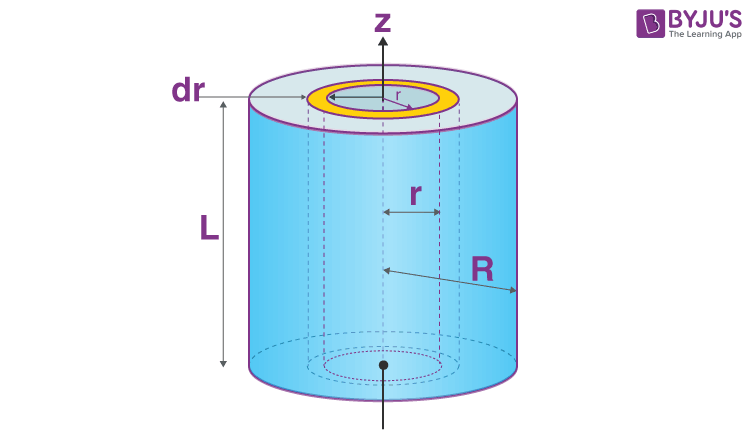Moment of inertia of a solid cylinder about its centre is given by the formula;
\(\begin{array}{l}I = \frac{1}{2}MR^{2}\end{array} \) |
Here, M = total mass and R = radius of the cylinder.
Derivation Of Moment Of Inertia Of Solid Cylinder
We will take a solid cylinder with mass M, radius R and length L. We will calculate its moment of inertia about the central axis.

Here we have to consider a few things:
- The solid cylinder has to be cut or split into infinitesimally thin rings.
- Each ring consists of the thickness of dr with length L.
- We have to sum up the moments of infinitesimally these thin cylindrical shells.
We will follow the given steps.
1. We will use the general equation of moment of inertia:
dI = r2 dm
Now we move on to finding the dm. It is normally given as;
dm = ρ dV
In order to obtain dm we have to calculate dv first. It is given as;
dV = dA L
Meanwhile, dA is the area of the big ring (radius: r + dr) minus the smaller ring (radius: r). Hence;
Notably, here the (dr)2 = 0.
2. Substitution of dA into dV we get;
Now, we substitute dV into dm and we will have;
dm = (2πrdr)Lρ
The dm expression is further substituted into the dI equation and we get;
3. Alternatively, we have to find the expression for density as well. We use the equation;
Now,
4. The final step involves using integration to find the moment of inertia of the solid cylinder. The integration basically takes the form of a polynomial integral form.
I = 2MR2/4
Therefore,
⇒ Check Other Object’s Moment of Inertia:
- Moment Of Inertia Of A Cylinder
- Moment Of Inertia Of A Hollow Cylinder
- Moment Of Inertia Of A Rectangular Plate
- Moment Of Inertia Of Rectangle
- Moment Of Inertia Of Rod
Parallel Axis Theorem

Comments